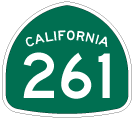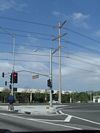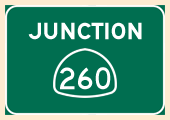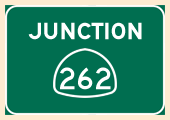California 261 is a toll road that connects the cities of Irvine and Santa Ana with California 241, which is known as the Foothill Transportation Corridor south of California 133 and as the Eastern Transportation Corridor north of California 133. There is no direct connection from California 261 to Interstate 5; the tollway is primarily designed to provide access from new residential development in the foothills with job centers in the cities of Irvine and Tustin.
| Jamboree Road north |
|
Northbound Jamboree Road approaches Interstate 405 (San Diego Freeway) at the upcoming folded diamond interchange. The first ramp connects to Interstate 405 south to San Diego, while the second ramp links to Interstate 405 north to Long Beach. Photo taken 01/30/05. |
|
Interstate 405 is a major northwest-southeast freeway that serves the cities of Irvine, Costa Mesa, Fountain Valley, and Westminster in Orange County. Photo taken 01/30/05. |
|
Northbound Jamboree Road meets the off-ramp to Interstate 405 south to San Diego. Photo taken 01/30/05. |
|
After passing over the busy Interstate 405 freeway, northbound Jamboree Road meets the loop ramp connecting to Interstate 405 northwest to Costa Mesa, Fountain Valley, Westminster, and Long Beach. Photo taken 01/30/05. |
|
Northbound Jamboree Road transitions directly onto California 261 north in the city of Irvine. This mileage sign provides the distance to the next two exits on Jamboree Road (Edinger Avenue and Walnut Avenue) and the point where Jamboree Road connects directly with California 261 north. Photo taken 01/30/05. |
|
Jamboree Road meets Edinger Avenue at this off-ramp. Continue ahead to the next two exits: Walnut Avenue and the split between California 261 and Jamboree Road. None of these three exits (Edinger Avenue, Walnut Avenue, and California 261/Jamboree Road) split have exit numbers. Photo taken 01/30/05. |
|
Upon exiting, the off-ramp from northbound Jamboree Road splits for Edinger Avenue west or east . This is a single-point urban interchange. Photo taken 01/30/05. |
| California 261 (Eastern Transportation Corridor) - Irvine-Tustin Spur south |
|
California 261 is the Eastern Transportation Corridor spur that leads south from California 241 into southern Tustin and northern Irvine. This view looks south along California 261 immediately after the split from California 241 near Irvine Lake (Santiago Reservoir). Photo taken 05/02/10. |
|
California 261 passes under Santiago Canyon Road (Orange County S-18). There is no access from California 261 to Santiago Canyon Road or Chapman Avenue on the assumption that traffic from California 241 south would have used Exit 33 on that toll road. Photo taken 05/02/10. |
|
The first California 261 south reassurance shield is posted after the on-ramp from Santiago Canyon Road. Photo taken 05/02/10. |
|
This view looks southwest along California 261 toward Tustin and Irvine. Photo taken 05/02/10. |
|
A second California 261 south reassurance shield is posted prior to the first exit from southbound: Exit 3, Portola Parkway. Photo taken 05/02/10. |
|
This mileage sign posted on California 261 south provides the distance to Exit 3, Portola Parkway; the Irvine Ranch Toll Plaza; and Exit 2, Irvine Boulevard. Photo taken 05/02/10. |
|
The next three exits from California 261 south (Exit 3, Portola Parkway; Exit 2, Irvine Boulevard; and Exit 1, Walnut Avenue) all serve the cities of Tustin and Irvine. California 261 will straddle the limits between the two cities from here southwest to its end after passing under Interstate 5. Photo taken 05/02/10. |
|
A second mileage sign on California 261 south again provides the distance to Exit 3, Portola Parkway; the Irvine Ranch Toll Plaza; and Exit 2, Irvine Boulevard. Photo taken 05/02/10. |
|
The first exit along California 261 south is Exit 3, Portola Parkway, which links the toll road to Irvine to the east and Tustin to the west. Photo taken 05/02/10. |
|
Southbound California 261 reaches Exit 3, Portola Parkway. Ahead, through traffic on California 261 approaches the Irvine Ranch Toll Plaza. Photo taken 05/02/10. |
|
Through traffic on California 261 must pay a toll prior to the interchange with Irvine Boulevard. Stay left to use the FasTrak (electronic toll) lanes, or merge right for the cash toll plaza. Photo taken 05/02/10. |
|
California 261 leaves unincorporated Orange County and enters the city of Irvine as it continues northeast toward Interstate 405 and Interstate 5. Irvine, which incorporated on December 28, 1971, is a master planned city that is home to the University of California at Irvine and features a variety of developments and neighborhoods. Irvine a population of 143,072 as of the 2000 Census. Photo taken 05/02/10. |
|
Motorists on California 241 south entered a hazardous fire area near the Windy Ridge Toll Plaza; upon passing into the Irvine Ranch Toll Plaza, travelers on California 261 south leave the hazardous fire area. Photo taken 05/02/10. |
|
The main lanes of California 261 south split at the Irvine Ranch Toll Plaza. Stay left for FasTrak or exit here for the cash toll plaza. When we went through here in May 2010, the toll plaza had no attendants, just a cash/change machine used to pay the toll. Photo taken 05/02/10. |
|
This view looks south along California 261 toward the Irvine Ranch toll plaza. Photo taken 05/02/10. |
|
Over in the FasTrak lanes is an advance sign for Exit 2, Irvine Boulevard (0.75 mile). The cash lanes from the Irvine Ranch toll plaza will rejoin the main lanes ahead. Photo taken 01/30/05. |
|
After the electronic toll lanes and cash lanes merge back together, this sign advises that there is no direct connection from California 261 south to Interstate 5 (Santa Ana Freeway). To make that connection, use Exit 2 and connect to Interstate 5 via Irvine Boulevard west to Jamboree Road south. Photo taken 05/02/10. |
|
A California 261 south reassurance shield is posted shortly thereafter. Photo taken 05/02/10. |
|
Irvine Boulevard is a major arterial roadway that leads northwest into Tustin and southeast toward the Northwood community of Irvine. Photo taken 05/02/10. |
|
Southbound California 261 reaches Exit 2, Irvine Boulevard. The next interchange along California 261 south is Exit 1, Walnut Avenue and Edinger Avenue. Photo taken 05/02/10. |
|
California 261 passes under Irvine Boulevard. Photo taken 05/02/10. |
|
The remaining distance of California 261 was constructed below grade. Photo taken 05/02/10. |
|
California 261 remains below grade as the freeway passes under Bryan Avenue (shown here) and El Camino Real (next overpass). Photo taken 05/02/10. |
|
This mileage sign along California 261 south provides the distance to the next two exits: Exit 1, Walnut Avenue and Edinger Avenue and Exit 0, Warner Avenue. Photo taken 05/02/10. |
|
California 261 passes under Interstate 5; there is no direct freeway-to-freeway access between the two routes. The state route will continue on for another mile or so, then end at the transition point into Jamboree Road. Photo taken 05/02/10. |
|
Southbound California 261 meets Exit 1, Walnut Avenue and Edinger Avenue. This is the final exit before California 261 merges onto Jamboree Road south. Photo taken 05/02/10. |
|
Looking at the off-ramp from California 261 to Exit 1, the left lane links to Walnut Avenue and Edinger Avenue. California 261 passes under Walnut Avenue first, then passes under Edinger Avenue second. The off-ramp directly links to both roads. Photo taken 05/02/10. |
|
The transition ramp that carries Jamboree Road northbound traffic over California 261 comes into view ahead. Photo taken 05/02/10. |
|
Curving through the Walnut Avenue interchange, California 261 sees a speed limit reduction. The toll road ends upon passing under the Walnut Avenue bridge (just ahead). Traffic from southbound Jamboree Road joins California 261 from the right; this will result in a widening of the freeway from two lanes to five lanes southbound. Photo taken 05/02/10. |
|
|
An end California 261 south route marker is posted in the median of California 261 south as the freeway passes under Walnut Avenue. In Orange County, most terminating state routes do not have an "end" sign, but an exception is this end California 261 shield located on the transition from the toll road onto Jamboree Road in Irvine. Ahead, the freeway continues as Jamboree Road. Photos taken 05/02/10 and 09/16/00. |
| Jamboree Road south |
|
With the added traffic from Jamboree Road, the southbound freeway widens to five lanes as the continuation of Jamboree Road. However, the state route has ended. Maintenance responsbilities for California 261 are with the Transportation Corridor Agencies (TCA), while Jamboree Road is locally maintained by the cities of Irvine and Tustin (as a brief segment of Jamboree Road passes into Tustin, then reenters Irvine). Photo taken 05/02/10. |
|
Now an Irvine city street, Jamboree Road proceeds southwest on a path roughly between the southern limits of Tustin and northern limits of Irvine. Photo taken 05/02/10. |
|
In fact, Jamboree Road briefly enters the city of Tustin ("Community Trees History Future"). Tustin incorporated in 1927, consists of 11.4 square miles, and was home to 67,504 people as of the 2000 Census. Ahead, Jamboree Road passes over Edinger Road, which is reached via the Exit 1 off-ramp (which is a very long distributor ramp from the freeway). Photo taken 05/02/10. |
|
|
|
This series of photos follows Jamboree Road as it proceeds south through the Edinger Avenue interchange. Visible to the north is the decommissioned Tustin U.S. Marine Corps Air Station (closed in 1999), which is slated for redevelopment. Photos taken 05/02/10. |
|
|
|
|
The final interchange along Jamboree Road (California 261 extension) south is Exit 0, Warner Avenue and Park Avenue. Photo taken 05/02/10. |
|
Southbound Jamboree Road meets the off-ramp to Warner Avenue and Park Avenue. At this interchange, Jamboree Road leaves Tustin and again enters the city of Irvine. Photo taken 05/02/10. |
|
|
|
This series of photos follows Jamboree Road as it proceeds south through the Warner Avenue interchange. A new shopping center located on the Tustin side of Jamboree Road comes into view. Jamboree Road continues with four southbound lanes, then approaches a signalized intersection with Barranca Parkway. This intersection will mark the end of the freeway segment connected by both California 261 and Jamboree Road. Photos taken 05/02/10. |
|
|
|
|
|
|
Southbound Jamboree Road meets Barranca Parkway at this traffic signal. A 230kV Southern California Edison power line crosses over the roadway. Ahead, Jamboree Road continues as a major arterial. Photos taken 05/02/10. |
|
Jamboree Road proceeds southwest through the city of Irvine, intersecting Alton Parkway along the way and now approaching Main Street. After the Main Street intersection, Jamboree Road will meet Interstate 405 (San Diego Freeway). Photo taken 05/02/10. |
|
|
Southbound Jamboree Road meets Interstate 405 (San Diego Freeway) at a folded diamond interchange. The first right links to Interstate 405 north to Long Beach; the second right connects to Interstae 405 south to San Diego. Photos taken 05/02/10. |
| California 261 scenes |
|
This trailblazer for California 261 is posted on the off-ramp from Interstate 5 (Santa Ana Freeway) north to Jamboree Road. This sign is necessitated by the lack of a direct connecting ramp from Interstate 5 north to California 261 north. Photo taken 03/09/08. |
|
|
Northbound Jamboree Road approaches Orange County S-18/Santiago Road, which travels east to meet California 261 and California 241. Photos taken 03/09/08. |
Page Updated May 11, 2012.







































































